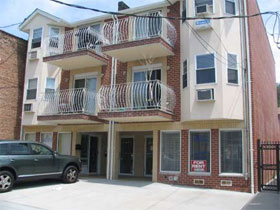How to Fix Off-Street Parking Policy, Before It’s Too Late
 On Monday we looked at how the proliferation of off-street parking is pushing New York toward higher rates of car ownership and substantially more traffic, based on the projections in Transportation Alternatives’ new report, Suburbanizing the City. To avert a scenario where the city becomes less transit-oriented and more beholden to car owners, a coalition of planning and environmental groups is calling for the reform of off-street parking policies. In a letter to Mayor Bloomberg, they urge the city to:
On Monday we looked at how the proliferation of off-street parking is pushing New York toward higher rates of car ownership and substantially more traffic, based on the projections in Transportation Alternatives’ new report, Suburbanizing the City. To avert a scenario where the city becomes less transit-oriented and more beholden to car owners, a coalition of planning and environmental groups is calling for the reform of off-street parking policies. In a letter to Mayor Bloomberg, they urge the city to:
- Fully assess the amount of existing and planned off-street parking.
- Consider measures to significantly reduce required parking.
- Revise environmental laws so that parking impacts are fully accounted for.
- Freeze special permits and stop directly subsidizing new parking.
The full slate of recommendations starts on the third page of this PDF. With more than a billion miles per year in extra car traffic on the way if current practices remain unchanged, advocates say the city must first acknowledge the impact of off-street parking. "What is almost as scary as all this new traffic is the fact that the city is not even aware of the problem," said T.A.’s Paul Steely White. "The Department of City Planning does not know how much parking exists, nor how the parking supply affects traffic congestion."
Decisions such as whether to allow developers to exceed parking limits in Manhattan are currently based on small-bore factors, like traffic counts on nearby streets. The cumulative impact of all the off-street parking that’s being added through these exemptions remains unknown. That hasn’t stopped the Planning Commission from approving a slew of them, the effects of which will be felt for decades. "The city takes a very local view of parking," said report author Rachel Weinberger. "They have to take a citywide view of what additional car ownership means."
The recommendations in the report, which were formulated by co-author’s John Kaehny and Weinberger, include a mix of incentives and other measures to stem the tide of excessive off-street parking. The widespread practice of "bundling" a parking spot with the price of housing, for instance, rewards car ownership and weighs down car-free households with an unnecessary cost. Cities including San Francisco, Chicago, and Washington, D.C. are moving away from this practice, and New York could do the same. Another concept is to nudge developers in less transit-oriented neighborhoods to include space for car-sharing instead of private cars.
Here’s a sampling of other ideas being proposed:
- Doing away with mandatory
parking minimums and instituting maximums that would vary based on a
development’s proximity to transit - Prioritizing the pedestrian
environment above the dictates of convenient parking by banning curb
cuts on key streets for pedestrians and transit - Establishing impact fees on new parking spaces that take into account their full costs to the public.
Streetsblog will
be taking a closer look at these recommendations and more in the weeks ahead.
Photo of residential driveway in Queens: Forgotten NY